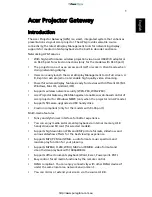
the Real-Time Transport Protocol (RTP) that is encrypted using
AES.
Secure Shell (SSH) is a network protocol that can be used to estab-
lish an encrypted connection to a device's shell.
The Service Set Identifier (SSID) defines a wireless network that is
based on IEEE 802.11. The SSID is the network name of the wire-
less LAN. All the access points and clients that belong to the same
network use the same SSID. The SSID string can be up to 32 char-
acters long and is placed, unencrypted, in front of all packets. A cli-
ent uses SSID ANY to contact all the accessible access points. The
user is then shown all the available WLANs and he can select the
appropriate network. If an access point is used for different net-
works, each wireless network is given a separate MSSID (Multi Ser-
vice Set Identifier).
Secure Sockets Layer (SSL) is a protocol for data encryption. Since
version 3.1, the new term Transport Layer Security (TLS) has been
used. SSL is mainly used for HTTPS to encrypt the data transmis-
sion between web server and web browser.
STAC is used to reduce the data volume transmitted (data compres-
sion).
In contrast to a dynamic IP address, the static IP address is as-
signed permanently by the user. Network components such as the
web server or printer usually have static IP address, while clients
such as notebooks or workstations usually have dynamic IP ad-
dresses.
Simple Traversal of User Datagram Protocol (UDP) Through Net-
work Address Translators (NATs). A STUN server enables VoIP
devices behind an active NAT to access the network.
As well as the ISDN telephone number, a sub-address can also be
sent when establishing the connection. This sub-address can trans-
mit any additional information. It can be used, e. g., to systematically
address multiple ISDN terminals that can be reached under one
telephone number, or to open particular programs on a PC.
A sub-network in an IP network is known as a subnet. A subnet is
defined like a normal network, via an IP address and (sub-)netmask
(IPv4) and prefix length (IPv6). Example: 192.168.1.250/24
(192.168.1.250/255.255.255.0, 256 possible IP addresses) is a sub-
net of 192.168.1.250/16 (192.168.1.250/255.255.0.0, 65536 pos-
Glossary
bintec elmeg GmbH
540
bintec RS Series
















































